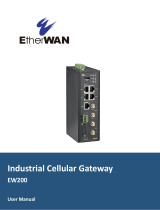
3.2.5.2 IPSec Server.....................................................................................................................50
3.2.5.3 IPSec................................................................................................................................. 54
3.2.5.4 GRE....................................................................................................................................56
3.2.5.5 L2TP.................................................................................................................................. 57
3.2.5.6 PPTP................................................................................................................................. 59
3.2.5.7 OpenVPN Client...............................................................................................................61
3.2.5.8 OpenVPN Server..............................................................................................................63
3.2.5.9 Certifications................................................................................................................... 65
3.2.6 IP Passthrough........................................................................................................................... 67
3.2.7 Routing.........................................................................................................................................68
3.2.7.1 Static Routing.................................................................................................................. 68
3.2.7.2 RIP..................................................................................................................................... 68
3.2.7.3 OSPF................................................................................................................................. 71
3.2.7.4 Routing Filtering.............................................................................................................. 77
3.2.8 VRRP.............................................................................................................................................77
3.2.9 DDNS............................................................................................................................................ 79
3.3 System.....................................................................................................................................................81
3.3.1 General Settings......................................................................................................................... 81
3.3.1.1 General..............................................................................................................................81
3.3.1.2 System Time....................................................................................................................82
3.3.1.3 Email................................................................................................................................. 84
3.3.2 Phone&SMS.................................................................................................................................85
3.3.2.1 Phone................................................................................................................................85
3.3.2.2 SMS................................................................................................................................... 86
3.3.3 User Management......................................................................................................................88
3.3.3.1 Account............................................................................................................................ 88
3.3.3.2 User Management.......................................................................................................... 89
3.3.4 SNMP........................................................................................................................................... 90
3.3.4.1 SNMP................................................................................................................................ 90
3.3.4.2 MIB View...........................................................................................................................91
3.3.4.3 VACM................................................................................................................................ 91
3.3.4.4 Trap................................................................................................................................... 92
3.3.4.5 MIB.................................................................................................................................... 93
3.3.5 AAA...............................................................................................................................................93
3.3.5.1 Radius............................................................................................................................... 93
3.3.5.2 TACACS+..........................................................................................................................94
3.3.5.3 LDAP................................................................................................................................. 95
3.3.5.4 Authentication................................................................................................................. 96
3.3.6 Device Management.................................................................................................................. 96
3.3.6.1 DeviceHub........................................................................................................................ 96
3.3.6.2 Milesight VPN..................................................................................................................97
3.3.7 Events...........................................................................................................................................99
3.3.7.1 Events............................................................................................................................... 99
3.3.7.2 Events Settings................................................................................................................99




















